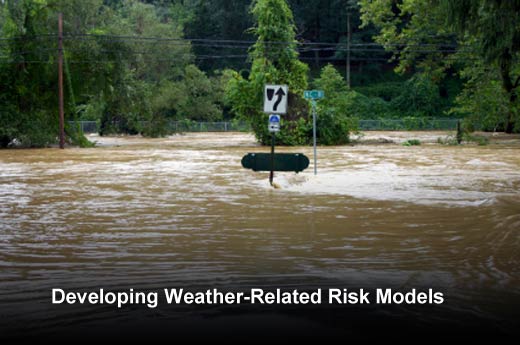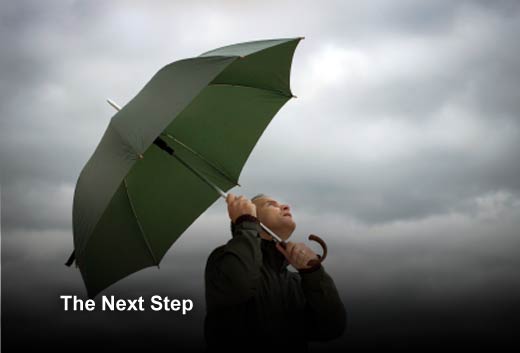A recent report, “Risky Business: The Economic Risks of Climate Change in the United States,” co-chaired by Michael R. Bloomberg, Henry Paulson and Tom Steyer, suggests that “by 2050 between $66 billion and $106 billion worth of existing coastal property will likely be below sea level nationwide, with $238 billion to $507 billion worth of property below sea level by 2100.”
Additionally, the U.S. National Research Council recently suggested the necessity of a “national vision” that will take precautionary, rather than reactionary, approaches to flooding, particularly in the Atlantic and Gulf coasts, where water has reached flood levels an average of 20 days per year since 2001.
These reports, however, don’t address what businesses should do to protect themselves from the increase of extreme weather changes or how to take on that task. For quite some time, solutions that incorporate a method known as Monte Carlo simulation (MCS) have been used to examine probability of weather risk and the financial impact those risks may produce.
So what is Monte Carlo simulation? MCS performs risk analysis by building models of possible results by substituting a range of values — a probability distribution — for any factor that has inherent uncertainty. It then calculates results over and over using a different set of random values from the probability functions.
Depending upon the number of uncertainties and the ranges specified for them, a Monte Carlo simulation could involve thousands or tens of thousands of recalculations before it is complete.
By using probability distributions, variables can have different probabilities of different outcomes occurring. Probability distributions are a much more realistic way of describing uncertainty in variables of a risk analysis. In this presentation, Randy Heffernan, vice president, Palisade, addresses common problems organizations may face when developing a model for weather risk, utilizing MCS.
Developing Weather-Related Risk Models
Click through for more on how Monte Carlo simulations can help businesses more realistically prepare for weather-related disasters, as identified by Randy Heffernan, vice president, Palisade.
Cost Predictions
Problem: When determining what actions to take, many companies or organizations typically do some kind of economic appraisal, such as a cost-benefit analysis that weighs the upfront capital expenditure versus the future returns from avoiding economic losses due to extreme weather events. However, climate change weather events are notoriously uncertain, making it difficult to pinpoint a return on investment.
Tip: Because of the very high number of permutations and combinations of weather events, it’s difficult to analyze these meaningfully using an averaged or deterministic approach. Monte Carlo simulation (MCS) overcomes this limitation by enabling literally thousands of possible combinations of extreme weather events to be analyzed. This presents a model that shows you a distribution of possibilities, as well as the level of their impact.
Economic Investment
Problem: When it comes to investing in preventative measures for protecting infrastructure or goods from unpredictable weather events, timing is everything. Invest too early — and the business may have substantial sunk capital expenditures, with little immediate benefit.
Tip: Use a discounted benefit-cost methodology — it helps rank and select a preferred strategy. Benefit-cost analysis also allows assessment of the relative social merits of potential adaptation measures. By incorporating risk analysis, you can determine optimal timing for implementing adaptation measures.
Hidden Costs
Problem: Your business has estimated the total cost of lost assets in the event of a climate change disaster event. Is this enough planning?
Tip: Not necessarily. It’s important to take into account all the ‘hidden’ costs when a disaster strikes. In the case of events such as storm surges or massive flooding, roads may be flooded and impassable for days, resulting in trucking and shipment detours and delays and thus increasing the cost of freight delivery. Shops and factories may stay closed for repairs — resulting in a loss of revenue, while employees will likely have to take leave — either paid or unpaid. It’s vital to incorporate these more indirect costs into your risk analysis models when planning for climate change events.
Regional Vulnerabilities
Problem: Your organization is located in a region that’s vulnerable to natural disaster — but no events have happened in decades. You want to use risk analysis in your future plans, but don’t know how to account for the possibility of disaster.
Tip: Use extreme value analysis (using statistics to deal with extreme deviations from the median of a distribution) to better model the likelihood of increasingly frequent and severe climate events.
Probabilities
Problem: You’ve run the numbers and know that the likelihood of a major storm surge on your real estate property is very low. No need to worry, right?
Tip: Not quite. It’s important to not only quantify the vulnerability of your assets, but also the consequence of failure for each of your assets. Even when the probability of asset damage is low, if the impact of its damage is severe, mitigating action may need to be taken.
Renewable Technologies
Problem: You’re thinking ahead, looking to incorporate renewable technologies into your energy resource pool. How should you approach integrating these new resources?
Tip: Because these relatively new sources of power have uncertain profit margins, they require detailed analysis. Make sure to use probabilistic risk analysis, including Monte Carlo simulation to account for the several unknowns involved — including untested technologies, government incentives, and complex, novel supply chains.
The Next Step
Problem: You’ve used quantitative risk analysis to quantify the likelihood, and impact, of a climate change disaster. What’s the next step?
Tip: Now it’s time to model your response to climate change — create a data set with a range of potential adaptation options or responses, which can be analyzed for cost-efficiency and likelihood of effectiveness. Adaptation measures can have high capital and ongoing maintenance costs, so businesses and organizations need to demonstrate value for money and a return on their investment. Thus, optimization techniques are crucial — they allow you to determine the timing and scale of mitigation measures, ensuring that any commitments to capital expenditures will have a likely maximum return on investment.










